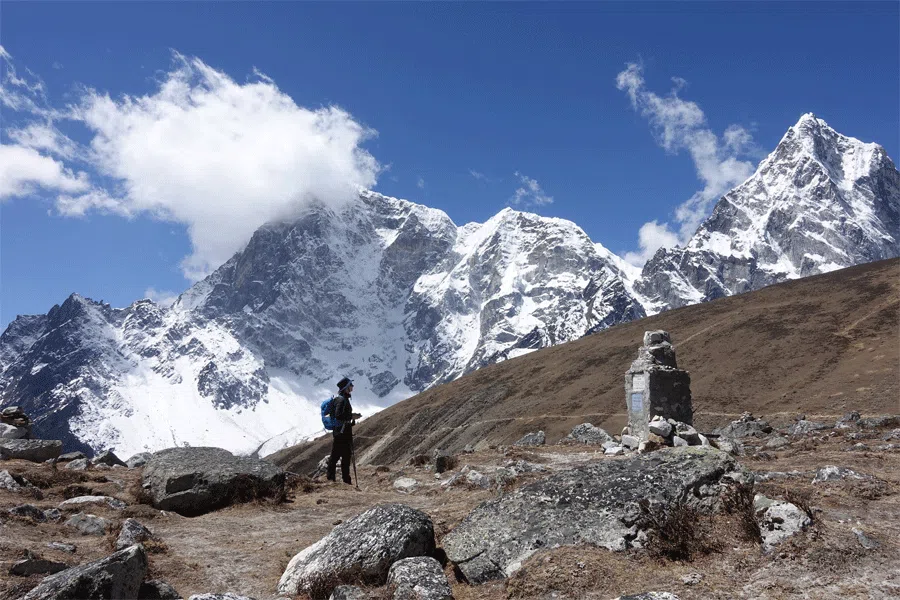Essential training for Everest base camp trek and preparation guide

We will examine how to prepare for the Everest Base Camp climb in this essential training guide, emphasizing the value of rigorous training for a safe and fun journey. The Everest Base Camp trek is a strenuous adventure that requires excellent health; it’s not just a stroll.
The Everest Base Camp Trek involves facing altitudes ranging from 9,000 to 17,600 feet while navigating rough roads, steep climbs, and challenging descents. It takes consistent and diligent training dedication to handle the physically demanding situations and take in the spectacular splendor of the Himalayas.
This guide will take you step-by-step through every aspect of preparing for the Everest Base Camp Trek while offering a detailed plan. We will go over all you need to know to ensure that your trip to the Himalayas is not only aesthetically pleasing but also healthy.
FOR MORE INFORMATION CLICK HERE : eid ul adha gift
Prepare yourself to embark on a life-changing adventure within the breathtaking Everest region by learning all you can about the Everest Base Camp Trek.
How to get prepared for the trek of a lifetime: things to consider
It’s wonderful to get ready for a hiking trip in Nepal, which offers breathtaking views and fascinating experiences. But wait! Make sure your body is ready for the hike before donning your hiking boots. We will look at how to register for trekking in Nepal in this tutorial. It is important to have the right training for the Everest Base Camp Trek.
FOR INFORMATIVE CONTENT VISIT.. : Corporate Gifts
It takes planning to be ready for a great trip, be it the wonderful trek to Everest Base Camp or any other significant travel. This simple plan is your road map to getting in shape for the exciting journey you have coming up. Regardless of your experience level, everyone can benefit from the advice in this article.
This approach, which is based on the excitement of scaling new heights and discovering new places, focuses on easy-to-follow steps. It recommends activities like brisk walking and cycling to strengthen your heart and strengthen your muscles with workouts like lunges and squats.
Thus, keep in mind that every little step you take toward your Short Everest Base Camp Trek will get you closer to the adventure as you begin your training. Fasten your boots, prepare for the voyage, and allow this guide to help you get extremely fit for the adventure that lies ahead!
By combining cardiovascular training, strength training, altitude training, and mental preparation, you’ll enter this adventure with confidence and be ready to enjoy every second spent surrounded by the magnificent peaks of the arena’s highest mountains.
1. Book Your Trek:
Making ensuring your trip is planned should be your first priority. If you’re the type of person who puts things off, purchasing your plane tickets and beginning your training earlier can cause a frenzy for the Everest Base Camp Trek.
It is easier to create and work toward a healthy goal when you have a strategy and a date for your excursion. You’ll also find it more difficult to come up with an excuse because you’ve already paid for the trip, which will motivate you to start preparing for your hike.
2. Understanding the Adventure:
Trekking in Nepal is an experience unlike any other; it requires a particular level of fitness. The areas you may traverse contain vast expanses of diverse, occasionally challenging terrain at particular elevations.
If you want to virtually enjoy trekking in Nepal, you should make sure your body is ready for the physical demands of walking through these varied and occasionally challenging terrain.
Equipping yourself with such gear not only improves your experience but also increases the security and enjoyment of your journey through Nepal’s breathtaking natural surroundings.
3. Boost Your Stamina for Hiking in the Himalayas
The majority of treks in Nepal climb to elevations of at least 4000 meters. At Kala Patthar, the extraordinary and well-known Everest Base Camp Trek reaches a height of 5545 meters. The air is thin up there, so breathing could be challenging. Therefore, in order to handle such circumstances, having a strong heart and lungs is essential.
This is where aerobic training comes into play; it’s akin to superhero training for mountain trekking. Incorporate some energetic, high-energy physical sports into your training regimen. You can aim to improve your riding, swimming, rowing, or jogging. Your heart and lungs will get extraordinarily robust from these sports.
The more aerobic training you have, the easier it will be to breathe and feel good while you’re up late, when the air is thin and your breathing may become a little difficult.
4. Cardiovascular Fitness:
According to the hiking squad, having healthy lungs and heart is practically necessary for trekking. They get healthy in this way. Walking, strolling, or regular bike rides are examples of smooth activities that can have a significant impact.
Engaging in these exercises promotes a higher oxygen utilization rate in your body, which is beneficial and crucial for climbing and descending unusually high altitudes. Strengthening your heart and lungs not only makes you longer in the end, but it also prepares your body to handle the challenging aspects of trekking in remote locations and at altitudes.
5. Building Strength:
The trails in Nepal can be quite steep and uneven, so leg strength is essential. The hiking team suggests performing power training exercises for your reoccurring pain, such as lunges, squats, and calf lifts. It’s also a great idea to strengthen your core with exercises like planks for increased stability on those challenging paths.
Trekking can be taxing on your muscles because it requires you to walk on steep terrain for extended periods of time. Strength exercise is essential, especially for your core and legs, as it diminishes again. Exercises like squats, lunges, deadlifts, and other sports will strengthen those muscular groups, reducing soreness and enhancing your experience on the hike.
With this simple instructions, you can get ready for your journey in Nepal. Don’t forget to start your Everest Base Camp Trek preparation early, remain committed, and relish your adventure across the magnificent Himalayas!
6. Take Regular Hikes
Trek frequently before you go hiking to build up your muscles and become more proficient. Hiking teaches you how to make good use of your gear and body. You might have to learn how to control and steady bumpy floors while you’re on the trails.
To prevent crashes and mishaps on precarious terrain like loose rocks, slick ice, or snow, this experience is crucial. Bring a backpack that is equivalent to the weight you will be carrying in Nepal for your hikes. Choose pathways with inclinations and descents. When trekking in the Himalayas, walking on hilly paths is an excellent practice.
7. Altitude Simulation:
It’s necessary to acclimate to better hiking destinations. You can replicate the conditions of high places to your workouts even if you don’t stay in the mountains. Gradually increasing the difficulty of your physical activities is similar to training for obstacles you will encounter at higher altitudes.
This type of training helps your body adjust to significantly less oxygen and prepares you for the unique and hard conditions of high-altitude trekking. By engaging in this exercise, you can ensure that your body is prepared for any changes and can function correctly while you hike in remote areas.
8. Practice Breathing Exercises
Find out easy strategies to strengthen your lungs. The air is substantially less oxygenated at high altitudes, which might leave you feeling exhausted and short of breath. It helps to know how to breathe properly, like in the case of yoga’s “pranayama.”
These workouts improve blood flow to your body and control body temperature. For this reason, breathing might not be too difficult when strolling along mountain trails. It is essential that you perform such activities if you want your trip traveling to high altitudes to be more enjoyable.
9. Stay Healthy and Boost Your Immune System
A strong immune system keeps you active and healthy throughout hikes. Trails gather people from all over the world and spread disease. Health problems can be brought on by communal restrooms, dust, and cold weather.
Eat lots of fruits, vegetables, poultry, and dairy products to boost your immunity. Reduce the amount of fast food and increase the amount of protein-rich foods. To fight against colds and infections, eat plenty of magnesium, zinc, and vitamins C and D.
10. Break in Your Boots and Test Your Gear
Make sure your trekking boots fit properly on your feet before you embark on your adventure. To see if they are comfy, wear them on a couple hikes. Having uncomfortable boots for the length of a long hike can be quite unsettling.
Make sure the clothing and gear you’ll need for the walk feel comfortable by giving them a test. Having the right equipment and being comfortable are really important for your hiking trip. Therefore, make sure everything is comfortable and fits well before hitting the trails on foot.
11. Mental Preparation:
The hiking squad would not only emphasize the importance of physical fitness but also the importance of mentally preparing yourself. Not only is trekking tough on your physically, but it’s also tough on your mind.
At some time during the journey, it will be essential to engage in mind-calming activities such as mindfulness, meditation, or daydreaming in order to stay focused and outstanding. Engaging in those cerebral sports enhances your overall trekking experience by keeping you robust, serene, and curious.
Just as important as physical fitness is mental preparation, which will help you handle the challenging circumstances of the journey with a lovely and healthy perspective.
12. Some More Important Things
Our guide draws inspiration for its content from a well-known hiking group that specializes in trekking in Nepal. It is said to be vital to educate everything, including strength training, mental preparation, acclimatization to high altitudes, and physical health. The hiking team demonstrates how paying attention to each of these details is essential to properly preparation for hiking in Nepal’s challenging areas.
You may increase the strength, endurance, and mental toughness of your body by following their exact training method. You’ll enjoy a more enjoyable and thrilling trekking experience in Nepal’s breathtaking scenery in this way.
To ensure a thrilling and safe experience, getting physically prepared for hiking in Nepal is essential. By adhering to this straightforward guide, which was inspired by the hiking team’s invaluable insights, you’ll be well-prepared to face the trails and make experiences that will last a lifetime.
Put on your boots, train appropriately for the Everest Base Camp walk, and create lifelong memories from your adventure!
How to Get Proper Training for Everest Base Camp: A Short and Simple Guide
A thrilling adventure with breathtaking vistas, cultural insights, and an incredible sense of accomplishment awaits those who receive the proper training for the Everest Base Camp trek. However, in order to tackle the difficult terrain and high altitudes, physical organization is required.
It’s exciting to outfit yourself for the Everest Base Camp hike, but being ready is really essential. You will find all the necessary information in this simple training manual for your trip to the breathtaking Himalayas.
It is sparked by the hiking team’s astute suggestions and covers basic health and training topics. It suggests engaging in physical activity for your heart, such as walking and cycling, and strengthening your muscles with lunges and squats.
Additionally, recommendations for usage at high altitudes are included. Use this book as a companion as you lace up your boots for this epic journey. It provides simple advice on how to make your Everest Base Camp Trek training outstanding and successful!
To assist you prepare for the Everest Base Camp journey, we will look at the key components of preparation for this hike in this article.
1. Cardiovascular Fitness:
As this expedition approaches, you’ll be walking a lot and ascending some really steep trails. Try engaging in regular physical activities like cycling, running, walking, and going upstairs to prepare yourself for all that physical stuff.
Try to work out for at least thirty minutes three or four times a week—it really doesn’t have to be too smooth—by going for a nice walk or doing something that causes you to perspire a little.
2. Stamina Boosting Training
Increasing the potency of your stamina is essential if you want to be active and full of energy all day. Regular cardiovascular exercise, such as swimming, jogging, or fast walking, improves the function of your heart and lungs.
Additionally, engaging in physical activities that strengthen your muscles, such as lunges and squats, gives you general stamina. Take it easy at first and gradually increase the difficulty of the sports to help your body adjust and become more resilient.
Don’t forget to get enough rest, consume a diet rich in nutrients, and drink plenty of water. These actions will all help you become even more resilient.
3. Strength Training:
Make your legs, stomach, and upper body sturdy so that you can walk on uneven terrain and wear your bag. Perform leg workouts such as lunges, squats, deadlifts, and other steps. Aim for core exercises like planks and twists as well as upper body workouts like push-ups and pull-ups.
You’ll get strong and prepared for your voyage as a result! By performing these exercises on a daily basis, you may be better prepared to take on challenging workouts or anything that comes your way in day-to-day life with a lot of strength and energy.
4. Altitude Simulation:
Climbing to higher altitudes is challenging. You can’t imagine how far away Everest is from your house, but you could work out in areas with significantly less air or wear unusual masks. This lessens the chance that being so high would make you feel ill and gives your body time to adjust to breathing considerably less air.
It can also be helpful for people preparing for activities in mountainous areas where lower oxygen levels can present difficulties. This simulation approach is essential for comprehending and preparing for the physiological reactions linked to surroundings at high altitudes.
5. Hiking Practice:
Since you’ll be walking for hours every day, get in some practice trekking, progressively increasing the length of time and potential difficulty, and using the same equipment as the Everest trek. Not only does this improve your health, but it also makes it easier to break in your hiking boots and get used to wearing a backpack.
It’s a great idea to practice walking because you will be walking for a significant amount of the day. Walks should begin with small distances and gradually increase in length and difficulty. Put on the same clothes you could use for the Everest hike. This not only increases your strength but also eases the discomfort in your hiking boots and allows you to become accustomed to carrying a
6. Mental Preparation:
Being fit and well is only one aspect of preparation; you also want to be mentally ready. Develop your intellectual energy and resolve because the journey could be emotionally taxing. To remain calm and feel at the top, try mindfulness, meditation, or thinking about things that are important.
These techniques support maintaining composure, stress reduction, and a positive mindset. Mental practice is more than just knowing what to do; it also involves resilience and adopting the right frame of mind. Whether addressing a challenging situation or pursuing personal goals, having well-structured thoughts can enhance happiness and wellbeing.
7. Hydration and Nutrition:
It’s important to maintain your energy at high elevations. Maintain adequate hydration and eat a diet rich in carbohydrates, proteins, and healthy fats. Try a variety of snacks and foods throughout training to see what suits you best. Discover the local cuisine and incorporate it into your diet before the walk.
Maintaining your vitality when at high elevations is essential. Maintain proper hydration and know that a diet rich in carbohydrates, proteins, and healthy fats is balanced.
When preparing for the Everest Base Camp Trek, experiment with different snacks and meals to see what suits you best. Find out what local cuisine is like and incorporate it into your pre-trek eating plan.
8. Gradual Progression:
Avoid exerting yourself too quickly or too hard. Increase the difficulty of your workouts gradually to prevent mishaps. Pay attention to your body and modify your plan as necessary. Days of rest are equally as important as vigorous exercise.
Planning is essential for the special experience of properly training for the Everest Base Camp trip. You will be ready for this incredible adventure by focusing on your cardiovascular health, strength training, altitude simulation, hiking experience, mental preparation, hydration, diet, and steady development.
Recall that the key to overcoming obstacles and fully participating in the trek to Everest Base Camp is preparation.
The Final Wrap Up
You must take care of your entire body in order to get in shape and receive the right training for the Everest Base Camp journey. The hiking team is an expert group, so pay attention to their suggestions! Engage in heart-tightening workouts such as cycling and walking.
Strengthen your muscles by performing exercises like lunges and squats. Put on masks or practice in areas with less air to help you get acclimated to being up high. Walk a lot, increasing the difficulty level each time. Maintain a strong mind in addition to a strong body.
Try engaging in positive thought processes or practicing meditation. The guide we discussed, who was inspired by knowledgeable trekkers, helps you prepare mentally and physically for the Everest Base Camp experience. Prepare yourself for a breathtaking adventure in the stunning Himalayas!



